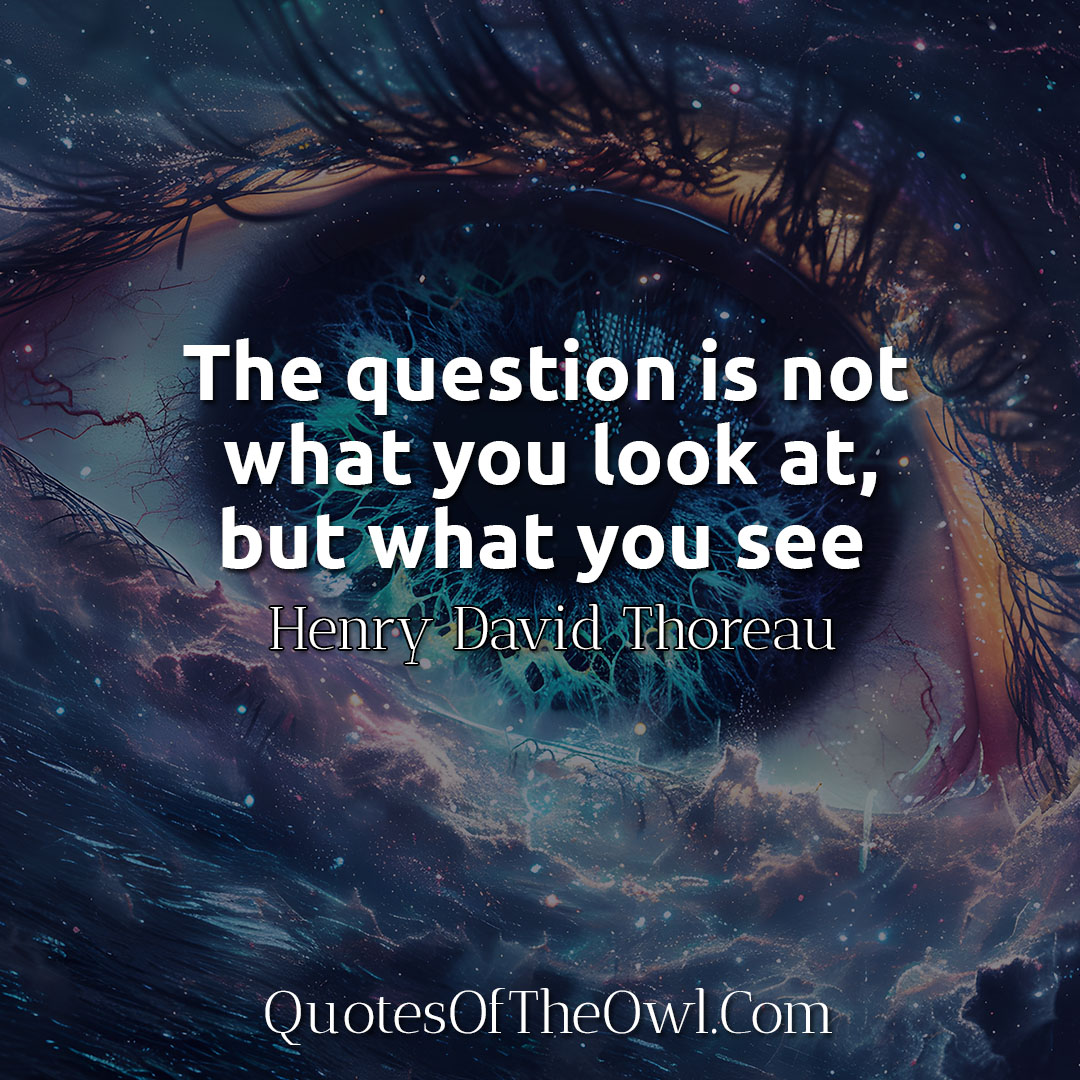The question is not what you look at, but what you see – Henry David Thoreau
Henry David Thoreau, a seminal figure in American literature and philosophy, left an indelible mark on the world with his introspective and profound thoughts on life, nature, and society. Among his many quotes, one stands out for its simple yet profound wisdom: “The question is not what you look at, but what you see.” This statement, at first glance, might seem straightforward, but it encapsulates a deep understanding of perception and reality. In this article, we will explore the layers of meaning behind this quote, delve into its philosophical roots, and discuss its relevance in our lives today.
Understanding the Context of the Quote
To fully appreciate the depth of Thoreau’s quote, it’s essential to understand the man behind it. Thoreau was not just a writer; he was a philosopher, naturalist, and social critic who spent much of his life contemplating the intricacies of existence. His most famous work, Walden, is a reflection of his two-year experiment in simple living, where he sought to understand life by stripping away the distractions of society. The quote, “The question is not what you look at, but what you see,” resonates with Thoreau’s broader philosophy, which emphasizes the importance of inner reflection and mindfulness.
Breaking Down the Quote: The Surface Meaning
At its most basic level, Thoreau’s quote draws a distinction between “looking” and “seeing.” To “look at” something is to observe it with your eyes—it’s a passive action, something that requires little more than a glance. On the other hand, “seeing” involves understanding, interpreting, and perceiving beyond the physical appearance. It is an active process that requires engagement and thought. In essence, Thoreau is telling us that it’s not enough to simply observe the world; we must strive to truly understand it.
The Deeper Meaning of the Quote
Beyond its surface meaning, Thoreau’s quote speaks to the concept of perception versus reality. Often, we go through life on autopilot, seeing only what is on the surface and missing the deeper truths that lie beneath. Thoreau challenges us to look beyond appearances and cultivate a deeper awareness of the world around us. This quote encourages mindfulness—a heightened state of awareness where one is fully engaged in the present moment, not just passively observing, but actively interpreting and understanding.
Thoreau’s Perspective on Nature and Observation
Thoreau’s connection with nature profoundly influenced his views on observation and perception. For Thoreau, nature was not just a backdrop for human activity but a source of wisdom and insight. In Walden, he often described his surroundings in meticulous detail, not just noting what he saw but what those sights meant to him. Thoreau believed that by closely observing nature, one could gain a deeper understanding of life itself. His quote reflects this belief, urging us to look at the world with a sense of wonder and curiosity, to see not just with our eyes but with our hearts and minds.
Applying Thoreau’s Quote to Everyday Life
So, how can we apply Thoreau’s wisdom to our daily lives? One way is by practicing active perception in our interactions and experiences. For instance, when we engage in conversations, do we truly listen to what the other person is saying, or are we merely hearing the words? Do we take the time to understand the emotions and intentions behind those words? By being more mindful and intentional in our daily activities, we can begin to “see” rather than just “look at” the world around us. This shift in perspective can lead to personal growth and a more meaningful life.
The Influence of Thoreau’s Ideas on Modern Thought
Thoreau’s ideas have had a lasting impact on modern philosophy, psychology, and even mindfulness practices. His emphasis on mindfulness and deep reflection is echoed in contemporary movements that advocate for greater awareness and intentionality in life. The quote, “The question is not what you look at, but what you see,” aligns closely with the principles of mindfulness, which encourage us to focus on the present moment and see beyond surface-level distractions. In today’s fast-paced world, where we are constantly bombarded with information, Thoreau’s words remind us to slow down and truly engage with our surroundings.
Thoreau’s Quote and Personal Interpretation
The beauty of Thoreau’s quote lies in its openness to personal interpretation. Each individual may find different meanings in it based on their experiences and perspective. For some, it might serve as a reminder to look beyond material success and focus on personal fulfillment. For others, it could inspire a deeper connection with nature or a more thoughtful approach to relationships. The subjective nature of perception means that what we “see” is often influenced by our inner world—our beliefs, values, and emotions.
Philosophical Implications of the Quote
On a philosophical level, Thoreau’s quote invites us to question our understanding of reality. What does it truly mean to “see”? Is it simply about visual perception, or does it involve a deeper awareness of the essence of things? Thoreau challenges us to move beyond superficiality and seek a more profound understanding of life. This idea resonates with existential philosophy, which often explores the tension between appearance and reality, encouraging individuals to look beyond the surface and search for deeper meaning in their existence.
The Role of Perception in Shaping Reality
Our perceptions play a crucial role in shaping our reality. The way we interpret the world around us influences our thoughts, emotions, and actions. Thoreau’s quote underscores the power of perception in determining how we experience life. If we only look at things on a superficial level, we might miss the richness and complexity that lie beneath. However, if we train ourselves to see more deeply, we can uncover layers of meaning that enrich our understanding and experience of the world.
Literary Examples Reflecting the Quote’s Essence
Thoreau’s insight is not unique to his own work; it resonates with a broader literary tradition that explores the theme of perception. For example, in F. Scott Fitzgerald’s The Great Gatsby, the protagonist’s pursuit of the American Dream is ultimately a quest for something deeper, beyond the material wealth he initially seeks. Similarly, in the works of poets like William Blake, there is a recurring emphasis on the difference between mere observation and true vision. These literary examples echo Thoreau’s sentiment, reminding us that what we see depends largely on how we choose to look.
Thoreau’s Quote in Art and Creativity
Thoreau’s philosophy also extends to the realm of art and creativity. Artists often strive to reveal truths that go unnoticed in everyday life, using their work to help others see the world in new and profound ways. The idea of “seeing” rather than just “looking” is central to the creative process. By interpreting and expressing the world through their unique lens, artists challenge viewers to question their own perceptions and to explore deeper meanings in the world around them.
The Quote in the Context of Modern Media
In the age of social media and 24-hour news cycles, the challenge of seeing beyond the surface has become even more pertinent. We are constantly bombarded with images and information, often curated and filtered to present a specific narrative. Thoreau’s quote serves as a cautionary reminder to not take everything at face value. Instead, we should strive to see beyond the headlines, to question the narratives presented to us, and to seek out deeper truths in a world that often prioritizes speed over substance.
Conclusion
Henry David Thoreau’s quote, “The question is not what you look at, but what you see,” continues to resonate because it speaks to a fundamental aspect of the human experience—our perception of reality. In a world filled with distractions and superficialities, Thoreau challenges us to dig deeper, to look beyond appearances, and to truly see the world around us. By embracing this mindset, we can live more mindful, meaningful lives, finding richness and depth in the everyday.

